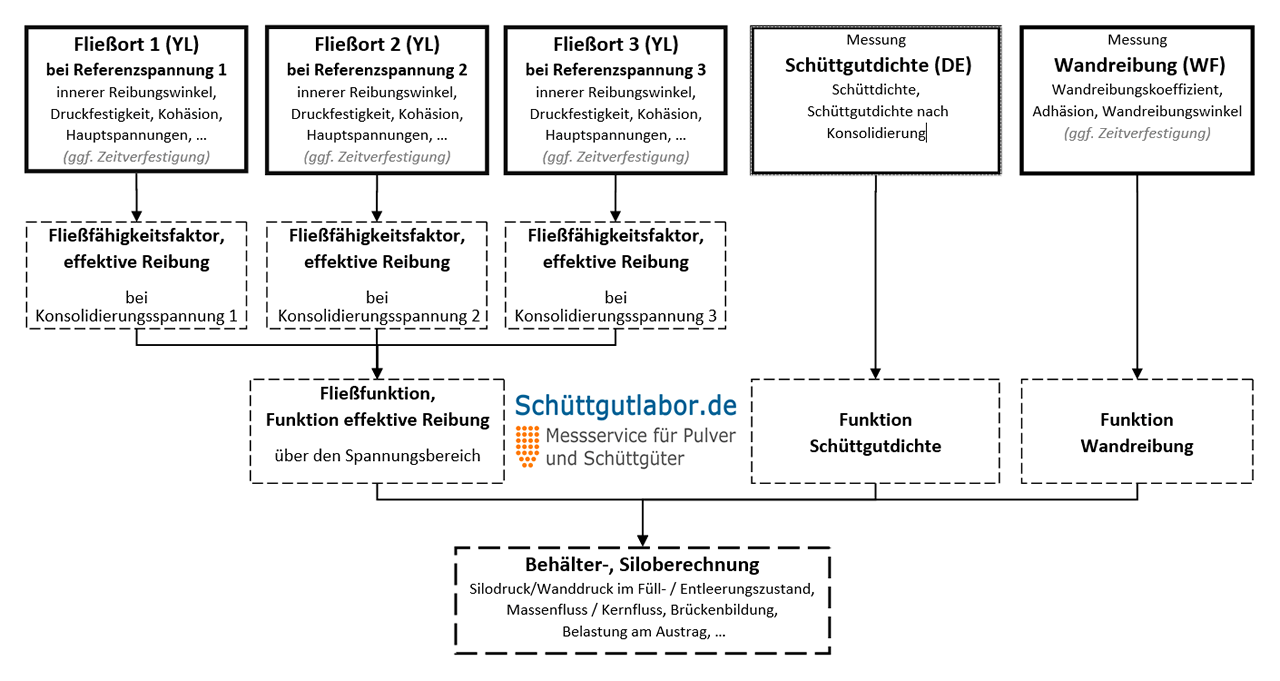Bulk Solids Technology - Measurements for Silo Design
Professional bulk solid measurements for technological silo design according to EN 1991-4. Measured material data for safe constructions.
By determining physical material properties of bulk solids, their behavior and effects on their environment can be predicted. These physical parameters serve in industry, research and development for material characterization, bulk solids technology and product design and allow users both qualitative and technological safety in the construction of bulk solid handling systems (silos, discharge units, ...).
Measured material data are the key to safe silo designs. EN 1991-4 explicitly recommends that "measured values should be preferred over estimated or tabulated values". We provide you with these precise measurement data for your technological silo design.
EN 1991-4 requires measured material data
Section 4.1.2 of EN 1991-4:
"The characteristic values of the bulk solid properties should be determined on the basis of test results. Measured values should be preferred over estimated or tabulated values."
Conclusion: Safe silo designs require precise measurement data - no tabulated values or estimates!
Measurements for Technological Silo Design

Identification of Flow Problems
We identify the causes and advise on concrete solution approaches for optimal material flows in your silos.
Common Flow Problems:
Arching in Silo
Arching prevents material flow due to too small discharge opening or unfavorable geometry
Mixed, Funnel or Rathole Flow instead of Mass Flow
- Different residence times of material in the silo - up to dead zones
- Segregation
- Irregular discharge
Eccentric Shaft Formation
Silo overloading due to eccentric stresses
Time Consolidation and Caking
Time consolidation leads to "dead zones" and blocked material flow
Segregation
Separation of different particle sizes or densities during filling and discharge
Dust Development
Health and explosion risks from fine dust suspension
Our Solution Approaches:
Precise Problem Analysis
Measurement and identification of critical properties
Geometry Optimization
Adaptation of silo geometry such as hopper inclinations, discharge openings, wall materials, fill quantities or activation aids
Flow Optimization
Achieving mass flow in the silo through targeted measures
Improve Material Properties
Limiting critical parameters such as moisture, particle size distribution
Discharge Aids
Agitators, vibrators, air injection to improve flow properties
Preventing Problems During Product Changeover
During product changeovers, the bulk solid properties often change as well. What works with one material can cause problems with another. However, potential problems can be identified and prevented early through prior analysis and testing.
Verification of Silo Suitability of New Materials
Pre-testing whether the new material works in existing plants
Comparative Measurements of New vs. Old Materials
Direct comparison of flow properties between old and new product
Compatibility Testing with Existing Plants
Assessment whether geometry and equipment are sufficient
Professional Silo Designs
Based on our measurement data, we support you in silo design according to EN 1991-4.
After completion of all necessary measurements for technological silo design, a calculation tool for designing silo geometry is additionally available. This enables the calculation of stresses and flow conditions in the silo based on common methods as well as according to EN 1991-4:
- Stresses in filling and discharge state
- Arching (critical discharge diameter)
- Limit criterion for mass or funnel flow
- Load on the discharge device
- etc.
You can adapt the silo geometry and calculation basis yourself based on the measurement data and check your design configuration. The results serve as design aid and estimation of stresses and flow conditions of the bulk solid in the silo. *Some calculation methods are based on commonly used empirical foundations and should therefore not replace expert silo design.
Comparison of Flow Properties of Bulk Solids
Objective comparison of different materials, batches or suppliers using standardized measurement procedures for quality assurance and product optimization.
Applications:
- Quality Control: Monitoring of batch variations
- Supplier Evaluation: Comparison of different raw material sources
- Product Development: Optimization of formulations
- Troubleshooting: Root cause analysis of flow problems
- Specification Creation: Definition of limit values
Measurement Parameters for Comparisons:
- Flowability index ffc: Quantitative classification
- Cohesion: Binding forces between particles
- Unconfined yield strength: Resistance to flow
- Wall friction: Friction at container walls
- Compressibility, compression behavior: Density change under load
30 Years of Expertise for Your Safety
Our long-standing experience in bulk solids technology, combined with state-of-the-art measuring equipment and standard-compliant evaluation, guarantees you precise results for safe and economical silo designs. Trust measured values instead of estimates!
Professional Bulk Solid Measurements for Your Silo Design
Do you need precise characterization of your bulk solid? Our laboratory offers standard-compliant measurements for safe silo designs according to EN 1991-4.
- ✓ Over 30 years of experience
- ✓ Standard-compliant measurements
- ✓ Detailed evaluation reports
- ✓ Complete material data determination
